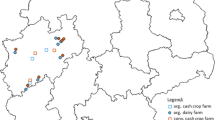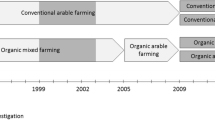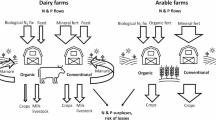Abstract
Organic agriculture is a production system which relies on ecosystem management and ecological processes rather than on the external flow of agricultural inputs. The development of the organic sector has induced a spatial decoupling of livestock and crop production. This has increased the flow of nutrients that occurs between farms compared to what happens within individual farms. Organic systems have replaced synthetic inputs with site-specific management practices to balance input and output nutrients to ensure short-term productivity and long-term sustainability. This paper addresses the nutrient management of mixed and specialized farming systems, with a special emphasis on the reliance on livestock production for the nutrient management of arable farmland. We assessed the nutrient budgets of nitrogen (N), phosphorus (P), and potassium (K) of 28 organic farms selected according to livestock density from three French counties. The farms were classified as stockless, mixed, and cattle farming systems. A soil surface nutrient budget was calculated for each farm based on inputs (N fixation, excreta, and manure) and outputs (grazing offtake, harvests) on annual crops and grasslands. Inputs due to N atmospheric deposition and seeds and losses due to leaching and volatilization were not considered in this study. Nutrient budgets of the 28 farms revealed N, P, and K deficits, although disparities between farming systems and their geographical location were also observed. Stockless farms presented high N deficit whereas mixed and livestock farming systems presented lower deficits (close to equilibrium) or even surpluses in a county with a high density of livestock farms. Differences between farming systems in terms of P and K budgets followed the same trend, but regional specificities appeared significant in stockless and livestock systems (related to the size of farms and the stocking rate). None of the farms purchased off-farm organic fertilizers when exchanges of manures and straw were observed at the regional scale. When livestock is present on the farm, the nutrient resources came mainly from recycling internal resources (manures, excreta, and N fixation), whereas stockless farming systems purchased organic manure from neighboring farms (14 to 58 % of total N inputs, 10 to 100 % of total P and K inputs). The sustainability of stockless organic farming systems is questioned, noticeably those that were located in regions where resources of organic matter are scarce. Only farming systems producing large quantities of manure or which purchased feed showed balanced nutrient budgets.


Similar content being viewed by others
References
Aronsson H, Torstensson G, Bergstrom L (2007) Leaching and crop uptake of N, P and K from organic and conventional crop** systems on a clay soil. Soil Use Manag 23:71–81. doi:10.1111/j.1475-2743.2006.00067.x
Berry PM, Sylvester-Bradley R, Philipps L, Hatch DJ, Cuttle SP, Rayns FW, Gosling P (2002) Is the productivity of organic farms restricted by the supply of available nitrogen? Soil Use Manag 18:248–255. doi:10.1079/sum2002129
Berry PM, Stockdale EA, Sylvester-Bradley R, Philipps L, Smith KA, Lord EI, Watson CA, Fortune S (2003) N, P and K budgets for crop rotations on nine organic farms in the UK. Soil Use Manag 19:112–118. doi:10.1079/sum2003176
Carlsson G, Huss-Danell K (2003) Nitrogen fixation in perennial forage legumes in the field. Plant Soil 253:353–372
Clement, A (2013) Etude des flux de matieres et d'elements en relation avec les prairies agricoles au sein d'un systeme de polyculture-élevage autonome en AB. ESITPA, Rouen. Data obtained in experimental organic farm at INRA Mirecourt from 2005–2012
CORPEN (1988) Bilan de l'azote à l'exploitation. Comité d'Orientation pour des Pratiques agricoles. Respectueuses de l'Environnement, Paris
CORPEN (1999) Estimation des flux d’azote, de phosphore et de potassium associés aux vaches laitières et à leur système fourrager. Comité d'Orientation pour des Pratiques agricoles Respectueuses de l'Environnement, Paris
CORPEN (2001) Estimation des flux d’azote, de phosphore et de potassium associés aux bovins allaitants et aux bovins en croissance, issus des troupeaux allaitants et laitiers, et à leur système fourrager. Comité d'Orientation pour des Pratiques agricoles Respectueuses de l'Environnement, Paris
Dalgaard T, Halberg N, Sillebak Kristense I (1998) Can organic farming help to reduce N-losses? Nutr Cycl Agroecosyst 52:277–287
David C, Jeuffroy MH, Laurent F, Mangin M, Meynard JM (2005a) The assessment of a decision making tool for managing the nitrogen fertilization of organic winter wheat. Eur J Agron 23:225–242
David C, Jeuffroy MH, Henning J, Meynard JM (2005b) Yield variation of organic winter wheat: a crop diagnosis on a field network in South-East of France. Agron Sustain Dev 25:1–11
David C, Abecassis J, Carcea M, Celette F, Friedel J, Hellou G, Hiltbrunner J, Messmer M, Narducci V, Peigné J, Sansom MF, Schweinzer A, Thomsen I, Thommen A (2013) Organic bread wheat production and market in Europe. In: Lichtfouse E (ed) Sustainable Agriculture Reviews 11, 43-62
Development Core Team R (2008) R: a language and environment for statistical computing. R Foundation for Statistical Computing, Vienna
D'Haene K, Magyar M, De Neve S, Palmai O, Nagy J, Nemeth T, Hofman G (2007) Nitrogen and phosphorus balances of Hungarian farms. Eur J Agron 26:224–234. doi:10.1016/j.eja.2006.10.005
Fangueiro D, Pereira J, Coutinho J, Moreira N, Trindade H (2008) NPK farm-gate nutrient balances in dairy farms from Northwest Portugal. Eur J Agron 28:625–634. doi:10.1016/j.eja.2008.01.007
Fortune S, Conway JS, Philipps L, Robinson JS, Stockdale EA, Watson C (2000) N, P and K for some UK organic farming systems ± implications for sustainability. In: Rees RM et al (eds) Sustainable management of soil organic matter. CAB International, Wallingford, pp 286–293
Gourley CJP, Powell JM, Dougherty WJ, Weaver DM (2007) Nutrient budgeting as an approach to improving nutrient management on Australian dairy farms. Aust J Exp Agric 47:1064–1074. doi:10.1071/ea07017
Hauggaard-Nielsen H, Gooding M, Ambus P, Corre-Hellou G, Crozat Y, Dahlmann C, Dibet A, von Fragstein P, Pristeri A, Monti M, Jensen ES (2009) Pea–barley intercrop** for efficient symbiotic N2-fixation, soil N acquisition and use of other nutrients in European organic crop** systems. Eur J Agron 28:625–634. doi:10.1016/j.eja.2008.01.007
Hellec F, Blouet A (2012) Technicite versus autonomie- Deux conceptions de l'elevage laitier biologique dans l'est de la France. Terrains Trav 20:157–172
Huss-Danell K, Chaia E, Carlsson G (2007) N-2 fixation and nitrogen allocation to above and below ground plant parts in red clover-grasslands. Plant Soil 299:215–226. doi:10.1007/s11104-007-9376-4
Korsaeth A (2008) Relations between nitrogen leaching and food productivity in organic and conventional crop** systems in a long-term field study. Agric Ecosyst Environ 127:177–188. doi:10.1016/j.agee.2008.03.014
Korsaeth A, Eltun R (2000) Nitrogen mass balances in conventional, integrated and ecological crop** systems and the relationship between balance calculations and nitrogen runoff in an 8-year field experiment in Norway. Agric Ecosyst Environ 79:199–214
Leclerc B (2001) Guide des Matières Organiques – Tome 2, 2nd edn. Institut Technique de l’Agriculture Biologique, Paris
Loges R, Kelm M, Taube F (2009) Comparative analysis of conventional and organic farming systems: nitrogen surpluses and nitrogen losses. In: Neuhoff D et al. (eds) Cultivating the future based on science. Volume 1: Organic crop production. Proceedings of the Second Scientific Conference of the International Society of Organic Agriculture Research (ISOFAR), 16th IFOAM Organic World Conference, Modena, Italy, pp 312–315
Marinari S, Mancinelli R, Carnpiglia E, Grego S (2006) Chemical and biological indicators of soil quality in organic and conventional farming systems in Central Italy. Ecol Indic 6:701–711. doi:10.1016/j.ecolind.2005.08.029
Mignolet C, Schott C, Benoît M, Meynard JM (2007) Spatial dynamics of farming practices in the Seine basin: Methods for agronomic approaches on a regional scale. Sci Total Environ 375:13–32
Mignolet C, Schott C, Benoît M, Meynard JM (2012) Transformation des systèmes de production et des systèmes de culture du bassin de la Seine depuis les années 1970: une specialisation des territoires aux conséquences environnementales majeures. Innovations Agronomiques 22:1–16. http://www6.inra.fr/ciag/Revue/Volume-22-Octobre-2012
Moller K (2009) Inner farm nutrient flows between arable land and permanent grassland via the stable in organic crop** systems. Eur J Agron 31:204–212. doi:10.1016/j.eja.2009.07.007
Nemecek T, von Richthofen JS, Dubois G, Casta P, Charles R, Pahl H (2008) Environmental impacts of introducing grain legumes into European crop rotations. Eur J Agron 28:380–393. doi:10.1016/j.eja.2007.11.004
Neumann A, Torstensson G, Aronsson H (2011) Losses of nitrogen and phosphorus via the drainage system from organic crop rotations with and without livestock on a clay soil in southwest Sweden. Org Agric 1:217–229. doi:10.1007/s13165-011-0017-0
Oenema O, Kros H, de Vries W (2003) Approaches and uncertainties in nutrient budgets: implications for nutrient management and environmental policies. Eur J Agron 20:3–16. doi:10.1016/s1161-0301(03)00067-4
Paillard S, Treyer S, Dorin B (2011) Agrimonde: scenarios and challenges for feeding the world in 2050. Quae, Paris
Pellerin S, Le Clech B, Morel C, Linères M (2004) Gestion de la fertilité phospho-potassique en agriculture biologique: questions posées et premiers résultats. CR Acad Agric Fr 89:30–34
Pelzer E, Bazot M, Makowski D, Corre-Hellou G, Naudin C, Al Rifai M, Baranger E, Bedoussac L, Biarnes V, Boucheny P, Carrouee B, Dorvillez D, Foissy D, Gaillard B, Guichard L, Mansard MC, Omon B, Prieur L, Yvergniaux M, Justes E, Jeuffroy MH (2012) Pea-wheat intercrops in low-input conditions combine high economic performances and low environmental impacts. Eur J Agron 40:39–53. doi:10.1016/j.eja.2012.01.010
Simon JC, Le Corre L, Vertes F (1994) Nitrogen balances on a farm scale: results from dairy farms in north west France. In: Grassland and society, Proceedings of the 15th General meeting of the European Grassland Federation, Wageningen (DEU), pp 429–433
Steinshamn H, Thuen E, Bleken MA, Brenoe UT, Ekerholt G, Yri C (2004) Utilization of nitrogen (N) and phosphorus (P) in an organic dairy farming system in Norway. Agric Ecosyst Environ 104:509–522. doi:10.1016/j.agee.2004.01.022
Ulen B, Aronsson H, Torstensson G, Mattsson L (2005) Nutrient turnover and risk of waterborne phosphorus emissions in crop rotations on a clay soil in south-west Sweden. Soil Use Manag 21:221–230
Watson CA, Atkinson D, Gosling P, Jackson LR, Rayns FW (2002a) Managing soil fertility in organic farming systems. Soil Use Manag 18:239–247. doi:10.1079/sum2002131
Watson CA, Bengtsson H, Ebbesvik M, Loes AK, Myrbeck A, Salomon E, Schroder J, Stockdale EA (2002b) A review of farm-scale nutrient budgets for organic farms as a tool for management of soil fertility. Soil Use Manag 18:264–273. doi:10.1079/sum2002127
Zenboudji EH (2012) Bouclage des cycles de nutriments au sein d'un système d'élevage herbager biologique. Université de Lorraine-ENSAIA, Nancy. Data obtained in experimental organic farm at INRA Mirecourt from 2005-2012
Acknowledgements
This work was partly financed by the Rhone-Alpes region in the research project CPER AB. We would like to thank Carl Holland and Linda Northrup for revising the text in English. Finally, we would like to give special thanks to the organic farmers from the three counties without whom this study would not have been possible.
Author information
Authors and Affiliations
Corresponding author
Rights and permissions
About this article
Cite this article
Foissy, D., Vian, JF. & David, C. Managing nutrient in organic farming system: reliance on livestock production for nutrient management of arable farmland. Org. Agr. 3, 183–199 (2013). https://doi.org/10.1007/s13165-014-0060-8
Received:
Accepted:
Published:
Issue Date:
DOI: https://doi.org/10.1007/s13165-014-0060-8




